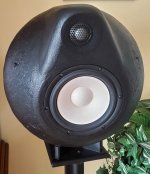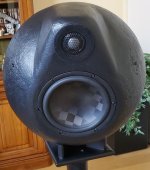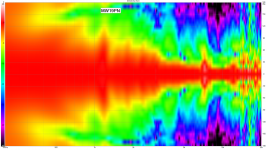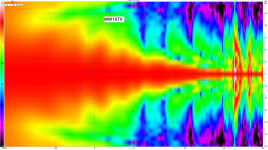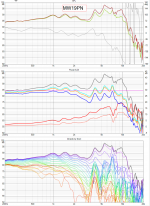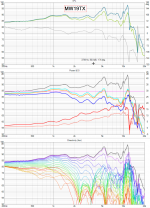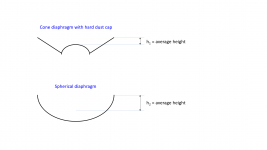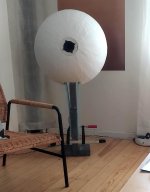Hello,
I renovated recently a pair of "boule Elipson" from the sixties with a SB Acoustics MW19PNW 4 Ohms and a Bliesma T25B.
As I received a pair of the textrene version (MW19TX-4) I did a series of measurements of both drivers exactly in the same conditions:
- measurement mic (Earthworks M30) on axis at 0.85 m from the front plate
- enclosure on my rotating table
- no crossover at all
- time window around 5 msec
The first two pictures is the enclosure with either the papyrus or the textrene driver.
The second two are the untouched horizontal +/- polar responses.
The last two are familiar to VituixCAD user
It can be seen immediately that:
- the problem with the surround a little above 1kHz has been corrected with the TX
- DI and Power response are worse with the TX version probably due to the shape of the diaphragm.
- not uploaded, but distortion figures are low on both version
Hope this could be of help for others...
I renovated recently a pair of "boule Elipson" from the sixties with a SB Acoustics MW19PNW 4 Ohms and a Bliesma T25B.
As I received a pair of the textrene version (MW19TX-4) I did a series of measurements of both drivers exactly in the same conditions:
- measurement mic (Earthworks M30) on axis at 0.85 m from the front plate
- enclosure on my rotating table
- no crossover at all
- time window around 5 msec
The first two pictures is the enclosure with either the papyrus or the textrene driver.
The second two are the untouched horizontal +/- polar responses.
The last two are familiar to VituixCAD user
It can be seen immediately that:
- the problem with the surround a little above 1kHz has been corrected with the TX
- DI and Power response are worse with the TX version probably due to the shape of the diaphragm.
- not uploaded, but distortion figures are low on both version
Hope this could be of help for others...
Attachments
very nice, but i do not understand what i see, can you tell some about the curves in the two last pictures?
Hello,
I renovated recently a pair of "boule Elipson" from the sixties with a SB Acoustics MW19PNW 4 Ohms and a Bliesma T25B.
As I received a pair of the textrene version (MW19TX-4) I did a series of measurements of both drivers exactly in the same conditions:
- measurement mic (Earthworks M30) on axis at 0.85 m from the front plate
- enclosure on my rotating table
- no crossover at all
- time window around 5 msec
The first two pictures is the enclosure with either the papyrus or the textrene driver.
The second two are the untouched horizontal +/- polar responses.
The last two are familiar to VituixCAD user
It can be seen immediately that:
- the problem with the surround a little above 1kHz has been corrected with the TX
- DI and Power response are worse with the TX version probably due to the shape of the diaphragm.
- not uploaded, but distortion figures are low on both version
Hope this could be of help for others...
The TX looks quite a bit better IMO. The breakup is pushed from 7khz to 10khz, and it's much smoother in its passband, nice between 400 and 2k.
Thanks for this!
Last edited:
I think the first breakup is around 5 kHz and the second about 11 kHz don't you think so ?
DI is reaching 10 dB at 2.2 kHz for the TX and 3.2 kHz for the PN. And this means to me that you have to choose a lower Fc for the TX !
DI is reaching 10 dB at 2.2 kHz for the TX and 3.2 kHz for the PN. And this means to me that you have to choose a lower Fc for the TX !
IMO only after correct filtering we can make proper comparisons. Filter both for, say, a fully optimized acoustic transfer function of a lowpass LR4@2.5kHz, and make a comparison then. Unfiltered does not tell us a whole lot..
Original purpose of my thread was to make a direct comparison between the payrus and the Textrene of the same driver in the same conditions. And we can see on polar response the difference specially in the 2 to 3 kHz region. It looks obvious to me
As I see, main difference in polar plots are in angle 90 to 180 degrees, this is probably mostly influenced from case you use.
It is probably closed case?
It is probably closed case?
Last edited:
It's hard to judge from this measurements, but TX seems like a smoother driver in desired range. Most that this is showing us is the influence of the cone shape.
I see this, and noticed it in another set of measurements. The textreme is not behaving in the mid 2000s.
Do you mean by 'not behaving' that the cone geometry (while cone movement is pistonic) causes trouble?
If the cone (or the surround) breaks up badly, the decay plot will show. If the cone moves well-behaved, the decay plot will show. Even a kind of diffraction on the edge and due to the too small ratio of the diameter of the sphere vs cone would show up in the decay plot.
A 'spatial issue' with such a small sphere is likely. But you mentioned other measurements, so what could be happening? Is it the driver or the combos?
A 'spatial issue' with such a small sphere is likely. But you mentioned other measurements, so what could be happening? Is it the driver or the combos?
I rest my case 😉 Not really, but I think we see some problems at 1,8k, 5k and 10k. Although the one at 1,8k probably is an interference (you see the shift in the time/frequency domain), the ones at 5 and 10k are cone breakups likely.
On the size of spheres: Harry Olson was the culprit that got us onto spheres long ago. What many seem to forget is that his measurements on sphere enclosures were undertaken with spheres at least five (5) times the diameter of the speaker in use, or even bigger. Part of that was his (probable) understanding that the transition of the cone edge to the spherical baffle has to be quite gradual and the sphere itself has to have major other dimensions than that of the rim-enclosure transition.
On the size of spheres: Harry Olson was the culprit that got us onto spheres long ago. What many seem to forget is that his measurements on sphere enclosures were undertaken with spheres at least five (5) times the diameter of the speaker in use, or even bigger. Part of that was his (probable) understanding that the transition of the cone edge to the spherical baffle has to be quite gradual and the sphere itself has to have major other dimensions than that of the rim-enclosure transition.
Do you mean by 'not behaving' that the cone geometry (while cone movement is pistonic) causes trouble?
Are you suggesting that is a contributing factor?
Interesting line of thought, but you guys didn't flesh it out the discussion.
I believe that the quasi-hemispherical shape of the TXT diaphragm will impact the off-axis performance. The average depth of the diaphragm is bigger than with a more conventional cone+dustcap (assuming the dustcap is a dome radiator, and most are these days).
The impact may not be a lot, but it will be there...
See my notional illustration...
Attachments
markbakk, the issue is that you have some problems that cannot be equalised. This is evident in the polar response. There is a problem in the mid 2,000s and an unexpected narrowing leading up to it. The CSD doesn't show it.
Do you mean by 'not behaving' that the cone geometry (while cone movement is pistonic) causes trouble?
I think we were on the same track. The CSD of course doesn't show problems in the polars. As Jim points out, it very well could be the deep 'cone'. But the CSD shows that there's something going on at 1,8k. As I don't suspect the enclosure itself, it probably is something cone/surround/rim related. Interference and directivity are one, as we all know.
I rest my case 😉 Not really, but I think we see some problems at 1,8k, 5k and 10k. Although the one at 1,8k probably is an interference (you see the shift in the time/frequency domain), the ones at 5 and 10k are cone breakups likely.
On the size of spheres: Harry Olson was the culprit that got us onto spheres long ago. What many seem to forget is that his measurements on sphere enclosures were undertaken with spheres at least five (5) times the diameter of the speaker in use, or even bigger. Part of that was his (probable) understanding that the transition of the cone edge to the spherical baffle has to be quite gradual and the sphere itself has to have major other dimensions than that of the rim-enclosure transition.
So I did good 🙂
Wideband globes
//
Attachments
Last edited:
- Home
- Loudspeakers
- Multi-Way
- SB Acoustic MW19PN & MW19TX direct comparison in the same enclosure
